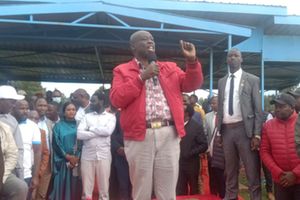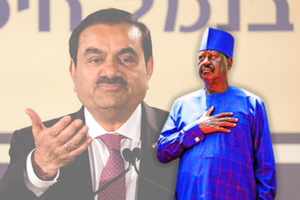2022 polls: Kalonzo Musyoka proves his value as other party leaders fumble

Wiper party leader Kalonzo Musyoka addressing congregants at Jesus Teaching Ministry in Donholm, Nairobi on August 21, 2022
Wiper leader Kalonzo Musyoka, passed over in the race for Raila Odinga’s running mate, has reinvented himself, increasing the number of elected leaders under his belt and cementing his place as the Ukambani political supremo.
Election results show the former Vice-President has stamped his authority in the politics of Ukambani after bagging the governor seats in the region – Machakos (Ms Wavinya Ndeti), Kitui (Dr Julius Malombe) and Makueni (Mr Mutula Kilonzo Jr) counties.
Mr Musyoka’s Wiper also won the three Senate seats – Agnes Kavindu (Machakos), Daniel Maanzo (Makueni) and Enoch Wambua (Kitui).
Further, the party has 20 MPs, the third-highest in the Azimio la Umoja One Kenya Coalition after ODM’s 76 and Jubilee’s 24.
In total, the three counties delivered 769,424 votes to Mr Odinga against President-elect William Ruto’s 250,070. This was, however, a bit lower compared to what the former Prime Minister got in 2017 – 968,437 votes.
Both Dr Alfred Mutua (Machakos governor) and Mr Johnson Muthama (UDA chairman) failed to deliver votes to DP Ruto despite being his stalwarts in the Lower Eastern region.
The raging Wiper wave in Ukambani notwithstanding, Dr Ruto got most of his votes from Mr Musyoka’s home county of Kitui. Kitui East MP Nimrod Mbai and his Mwala counterpart Vincent Musyoka were re-elected on UDA tickets.
The bulk of Mr Odinga’s votes (305,993) were from Machakos County, which, incidentally, was the highlight of Mr Musyoka’s victories despite Dr Mutua’s and Mr Muthama’s efforts.
At the same time, the outcome of the General Election has exposed some of the politicians in both camps who have failed to deliver to their leaders.
Both Dr Ruto and Mr Odinga were let down in the just concluded elections by some of the key politicians in their camps.
While Dr Ruto benefited from leaders such as Amani National Congress’ Musalia Mudavadi and Ford Kenya’s Moses Wetang’ula, he was let down by others such as outgoing Kilifi Governor Amason Kingi of Pamoja African Alliance, Mr Muthama, Dr Mutua and his presidential campaigns director Josphat Nanok.
Mr Odinga did not also get the much anticipated votes from some of his partners like President Uhuru Kenyatta, his running mate Martha Karua of Narc Kenya, Kanu chairman Gideon Moi, among others.
In President Kenyatta’s Mt Kenya region, Mr Odinga managed 22 per cent of the vote with 848,205 against Dr Ruto’s 2,939,902. While this percentage was much higher than what he got in 2017, it just was not enough to push him over the 50 per cent mark as he dropped votes in Western and Coast.
While Dr Ruto polled 630,282 votes in Western, up from 230,000 in 2017, Mr Odinga dropped from 1.2 million in 2017 to 976,233 in the August 9 polls. At the Coast, Mr Odinga had 649,913, while Dr Ruto added more than 50,000 votes on the UhuRuto 2017 tally to poll 336,478.
With Mr Odinga garnering less than 30 per cent from Mt Kenya, and lower than Azimio’s 40 per cent projection, allies of President Kenyatta insist that it is a good improvement for the ODM boss compared to previous elections.
Jubilee Secretary General Jeremiah Kioni said that the 22 per cent that Azimio got from the region was based on the efforts of the Jubilee leaders.
Despite promising to deliver more than 70 per cent of votes from the five Western Kenya counties – Busia, Kakamega, Vihiga, Bungoma and Trans Nzoia – Mr Mudavadi was unable to deliver the Vihiga County presidential vote to Dr Ruto. Voters in the county gave Mr Odinga 143,371 votes, representing 63.16 per cent of the valid votes in the county. On the other hand, Dr Ruto, who the ANC leader was supporting, had 79,722 or just about 35.96 per cent of the votes.
When details of the Kenya Kwanza Alliance agreement were made public – that Mr Mudavadi and Mr Wetang’ula needed to bring 70 per cent of the Western vote to get the goodies they were promised – the two laughed off the target as too low.
“Mimi na Wetang’ula tuko hapa. Ingo imeshona; 70 per cent ni kidogo. Tutaleta 90 per cent (Wetang’ula and I are here and we have consolidated our home; 70 per cent is too low. We will deliver 90 per cent,” Mr Mudavadi boasted then.
But the elections have shown that the man who is more valuable politically and has brought more votes and seats to Kenya Kwanza is Mr Wetang’ula.
Dr Ruto had 63 per cent of the votes in Bungoma County while Mr Odinga had 35.92 per cent.
Prof Masibo Lumala of Moi University opines that Azimio was sure of Kakamega and Busia counties, only Vihiga and Bungoma were battlegrounds.
“In Western, Vihiga and Bungoma had become battlegrounds. Vihiga has three dominant communities – Tiriki, Maragoli and Banyore. (Kenneth) Marende is from Bunyore, therefore, he had to push very hard knowing that he was assured of a comeback as a Speaker of the Senate,” Prof Lumala explained.
In Turkana, where Mr Nanok is the outgoing governor, ODM bagged the top county seat and Mr Odinga garnered slightly more than twice the votes Dr Ruto got.
With Mr Nanok on his side, the DP was confident of boxing Mr Odinga out of the semi-arid county, which has been voting overwhelmingly for the Azimio honcho since 2007. In 2017, Mr Odinga got 71,063 votes against 58,744 votes of President Kenyatta. In the August poll, Dr Ruto had 46,696 against Mr Odinga’s 96,117.
Vanquished
In the Rift Valley, Mr Moi was vanquished, including in his own Baringo backyard. The younger Moi, who has been the county Senator since 2013, was dealt a humiliating defeat by Baringo North outgoing MP William Cheptumo of UDA.
Baringo was regarded as the party’s political bedrock, being the hometown of the late President Daniel Moi who ruled the country for 24 years.
In all the six constituencies in Baringo, Mr Odinga only led in Tiaty, where Mr Moi’s ally, William Kamket, secured a second term in Parliament. Mr Odinga got 25,282 votes in the constituency against DP Ruto’s 5,708.




